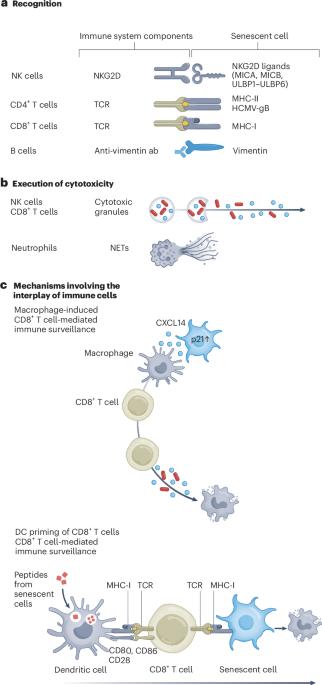Immune surveillance of senescent cells in aging and disease
IF 19.4
Q1 CELL BIOLOGY
引用次数: 0
Abstract
Senescent cells are intrinsically immunogenic and can be eliminated by the immune system to facilitate tissue repair and regeneration. However, immune-mediated elimination is compromised with age, causing senescent cell accumulation in tissues, thus limiting healthspan and lifespan and promoting age-related diseases such as cancer. Here, we review how different components of the innate and adaptive immune systems, including natural killer cells, macrophages, neutrophils, dendritic cells, T cells and B cells, target senescent cells and how the intrinsic properties of senescent cells can lead to their escape from surveillance. We also discuss the phenomenon of senescence in immune cells themselves and how this affects the surveillance of senescent and cancerous cells. Finally, we touch on emerging therapeutic strategies to enhance the immunosurveillance of senescent cells, as understanding the molecular basis of senescence immunosurveillance and why its potency fails during aging may offer opportunities to treat senescence-mediated age-associated diseases and tissue dysfunction. Majewska and Krizhanovsky discuss the interactions of innate and adaptive immune cells with senescent cells, including mechanisms of clearance, evasion and paracrine senescence, as well as therapeutic strategies to restore surveillance in aging and disease.

衰老细胞在衰老和疾病中的免疫监测。
衰老细胞本质上是免疫原性的,可以被免疫系统消除,以促进组织修复和再生。然而,免疫介导的消除随着年龄的增长而受损,导致组织中衰老细胞的积累,从而限制健康寿命和寿命,并促进与年龄有关的疾病,如癌症。在这里,我们回顾了先天免疫系统和适应性免疫系统的不同组成部分,包括自然杀伤细胞、巨噬细胞、中性粒细胞、树突状细胞、T细胞和B细胞如何靶向衰老细胞,以及衰老细胞的内在特性如何导致它们逃避监视。我们还讨论了免疫细胞本身的衰老现象,以及这如何影响对衰老细胞和癌细胞的监测。最后,我们谈到了增强衰老细胞免疫监测的新兴治疗策略,因为了解衰老免疫监测的分子基础及其效力在衰老过程中失效的原因可能为治疗衰老介导的年龄相关疾病和组织功能障碍提供机会。
本文章由计算机程序翻译,如有差异,请以英文原文为准。
求助全文
约1分钟内获得全文
求助全文

 求助内容:
求助内容: 应助结果提醒方式:
应助结果提醒方式:


